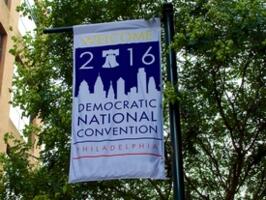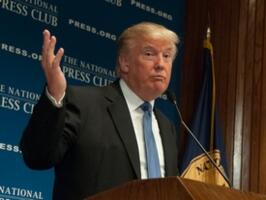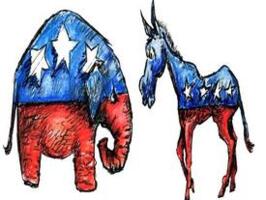GOP Convention: No Suspense, Little Drama, Lots of Show
A Commentary by Michael Barone
Today, the 40th Republican National Convention assembles in hurricane-threatened Tampa, Fla. Seven days later, the 46th Democratic National Convention will assemble in presumably non-hurricane-threatened Charlotte, N.C. Thousands of delegates, many thousands more press personnel and even more political enthusiasts will be on hand.
Vendors will sell political buttons to collectors (does anyone wear them anymore?), and party volunteers will hand out bumper stickers (though I haven't seen many on cars anywhere this year). Party fat-cats will attend elegantly catered receptions, and those lower on the political ladder will buy hot dogs from vendors or sample local cuisine (Cuban food in Tampa's Ybor City; North Carolina barbecue).
The conventions will adopt rules that don't matter (except possibly on delegate selection), adjudge credentials with utter predictability and adopt platforms that bind no one. And of course delegates will officially nominate Mitt Romney and Paul Ryan in Tampa and Barack Obama and Joe Biden in Charlotte.
People (and the federal government) will spend very large sums of money on all this. Many will ask why we still have national conventions at all.
They are a gift, for some an unwanted gift, from history. The national convention was originated by the long-departed Anti-Masonic Party in 1831 and copied by Andrew Jackson's Democrats in 1832. After the Republican Party was formed in 1854, it followed suit with a national convention in 1856.
Until the 1960s, the national convention was a communications medium. Political leaders in the various states seldom met each other, outside of sessions of Congress, during the four years between presidential elections.
Men did business well into the 1960s in written form: They spent their days reading their correspondence, dictating replies, and proofreading and signing their letters. Long-distance telephone calls were unusual; direct distance dialing was introduced only in the 1950s.
People ordinarily didn't put in writing their bottom-line negotiating position. Recipients sometimes ignored the command to "burn this letter." Better to wait until you could meet in person, in the convention city.
As a result, even the shrewdest politicians didn't know who had how many votes until the convention roll call was conducted. Campaign managers would hold back votes on early ballots to show momentum later. "Favorite son" candidates with support from home state delegations would wait for real contenders to bid for their support.
So there was suspense and drama to the proceedings. In 1960, John Kennedy got his majority for the Democratic nomination from Wyoming, the last state on the roll call. It was not until 1968 that the first media delegate count was conducted by Martin Plissner of CBS News.
The media delegate counts proved correct in the close 1976 Republican race between Gerald Ford and Ronald Reagan -- at which point the conventions started to take on their current form, as an advertisement for the presidential nominee and, perhaps secondarily, his party.
Sometimes things don't work out. Edward Kennedy avoided grasping Jimmy Carter's hand on the podium in New York in 1980, and Patrick Buchanan arguably overshadowed George H.W. Bush in Houston in 1992. But mostly things go according to script.
The Romney people have theirs prepared. Monday night is "we can do better," with the campaign trying to persuade one of the three broadcast networks to carry Ann Romney's speech. Tuesday is "we built that," with a Ron Paul video -- Hurricane Isaac permitting.
Wednesday is "the middle class agenda," with promises of more jobs and take-home pay. And Thursday, always the climactic night, is "we believe in America," with testimony about Romney's work in the Mormon Church and in the Salt Lake City Olympics and, of course, the nominee's acceptance speech.
The Romneyites are proud of their 3-D, high-resolution video screens (in the old days, delegates watched the tiny distant speakers), the podium inspired by Frank Lloyd Wright (a Wisconsin native, like Paul Ryan) and their efforts to interact with social media like Facebook and Twitter.
But of course it matters much more how the nominees, Ryan and especially Romney, come across. That's the whole point of still holding national conventions.
Some pundits lament the demise of the old conventions. But they couldn't be revived without banning long-distance telephone, the Internet and jet travel.
Contemporary conventions give parties a chance to showcase their nominees. As in much of our politics, an antique form still performs a useful function.
Michael Barone, senior political analyst for The Washington Examiner, is a resident fellow at the American Enterprise Institute, a Fox News Channel contributor and a co-author of The Almanac of American Politics.
COPYRIGHT 2012 THE WASHINGTON EXAMINER
DISTRIBUTED BY CREATORS.COM
See Other Political Commentaries.
See Other Commentaries by Michael Barone.
Views expressed in this column are those of the author, not those of Rasmussen Reports. Comments about this content should be directed to the author or syndicate.
Rasmussen Reports is a media company specializing in the collection, publication and distribution of public opinion information.
We conduct public opinion polls on a variety of topics to inform our audience on events in the news and other topics of interest. To ensure editorial control and independence, we pay for the polls ourselves and generate revenue through the sale of subscriptions, sponsorships, and advertising. Nightly polling on politics, business and lifestyle topics provides the content to update the Rasmussen Reports web site many times each day. If it's in the news, it's in our polls. Additionally, the data drives a daily update newsletter and various media outlets across the country.
Some information, including the Rasmussen Reports daily Presidential Tracking Poll and commentaries are available for free to the general public. Subscriptions are available for $4.95 a month or 34.95 a year that provide subscribers with exclusive access to more than 20 stories per week on upcoming elections, consumer confidence, and issues that affect us all. For those who are really into the numbers, Platinum Members can review demographic crosstabs and a full history of our data.
To learn more about our methodology, click here.



